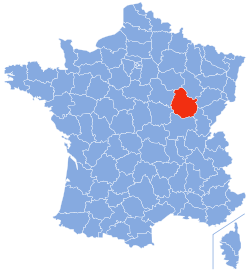Côte-d'Or(French pronunciation:[kotdɔʁ]ⓘ) is adépartementin theBourgogne-Franche-Comtéregionof Northeastern France. In 2019, it had a population of 534,124.[3]ItsprefectureisDijonandsubprefecturesareBeauneandMontbard.
Côte-d'Or | |
|---|---|
 Location of Côte-d'Or in France | |
| Coordinates:47°25′N04°50′E/ 47.417°N 4.833°E | |
| Country | France |
| Region | Bourgogne-Franche-Comté |
| Prefecture | Dijon |
| Subprefectures | Beaune Montbard |
| Government | |
| •President of the Departmental Council | François Sauvadet[1](UDI) |
| Area | |
• Total | 8,763 km2(3,383 sq mi) |
| Highest elevation | 723 m (2,372 ft) |
| Population (2022)[2] | |
• Total | 537,577 |
| • Rank | 50th |
| • Density | 61/km2(160/sq mi) |
| Demonyms | côte-d'oriens, costaloriens |
| Time zone | UTC+1(CET) |
| • Summer (DST) | UTC+2(CEST) |
| Department number | 21 |
| Arrondissements | 3 |
| Cantons | 23 |
| Communes | 698 |
| ^1French Land Register data, which exclude estuaries and lakes, ponds and glaciers larger than 1 km2 | |
History
editCôte-d'Or is one of the original 83 departments created during theFrench Revolutionon 4 March 1790. It was formed from part of the formerprovinceofBurgundy.It is arguably unique among the departments in having a name which is poetic, rather than geographic. Given by the representative of Dijon (fr:Charles-André-Rémy Arnoult), it is said to refer to the autumn gold of the flanks of the hills in the wine-growing area.[4][5]
Geography
editThe department is part of the currentregionofBourgogne-Franche-Comté.It is surrounded by the departments ofYonne,Nièvre,Saône-et-Loire,Jura,Aube,Haute-Saône,andHaute-Marne.
A chain of hills called the Plateau de Langres runs from north-east to south-west through the department to the north of Dijon and continues south-westwards as theCôte d'Or escarpment,from which the department takes its name. It is the south-east facing slope of thisescarpmentwhich is the site of the celebratedBurgundyvineyards.To the west of the Plateau de Langres, towardsChampagne,lies the densely wooded district of Châtillonais. To the south-east of the plateau and escarpment, the department lies in the broad, flat-bottomed valley of the middle course of theSaône.[6]
Rivers include:
- TheSaône
- TheSeinerises in the southern end of the Plateau de Langres.
- TheOucherises on the dip slope of the escarpment and flows to the Saône via Dijon.
- TheArmançonrises on the dip slope of the escarpment and flows north-westward.
- TheArrouxrises on the dip slope of the escarpment at the southern end of the department.
Climate
editThe climate of the department is continental, with abundant rain on the west side of the central range.
Principal towns
editThe most populous commune isDijon,the prefecture. As of 2019, there are 5 communes with more than 10,000 inhabitants:[3]
| Commune | Population (2019) |
|---|---|
| Dijon | 158,002 |
| Beaune | 20,551 |
| Chenôve | 14,025 |
| Talant | 11,713 |
| Chevigny-Saint-Sauveur | 11,123 |
Demographics
editThe inhabitants of the department are calledCostaloriens.
Population development since 1791:
|
| ||||||||||||||||||||||||||||||||||||||||||||||||||||||||||||||||||||||||||||||||||||
| |||||||||||||||||||||||||||||||||||||||||||||||||||||||||||||||||||||||||||||||||||||
| Sources:[7][8] | |||||||||||||||||||||||||||||||||||||||||||||||||||||||||||||||||||||||||||||||||||||
Politics
editThe President of the Departmental Council isFrançois Sauvadetof theUnion of Democrats and Independents.
| Party | seats | |
|---|---|---|
| Socialist Party | 12 | |
| • | Union for a Popular Movement | 11 |
| • | Miscellaneous Right | 8 |
| Miscellaneous Left | 6 | |
| Left Radical Party | 3 | |
| • | New Centre | 2 |
| • | MoDem | 1 |
Current National Assembly Representatives
editEconomy
editThis is a premierwine-growing regionof France. It produces what are arguably the world's finest, and definitely most expensivePinot noirandChardonnaywines from some of the most rigorously and painstakingly (thanks to the region's many monasteries) classified vineyards in the world. Wine from the Côte-d'Or was a favorite of the emperor Charlemagne. Other crops include cereal grains and potatoes. Sheep and cattle are also raised in the department. The region is famous forDijon mustard.
There are coal mines andheavy industry,including steel, machinery, and earthenware. The industries most developed in Côte-d'Or are
- agriculture and food (14% of employees)
- metallurgy and metal manufacture (12% of employees)
- chemicals, rubber and plastics (12% of employees)
- pharmacy
- electrical and electronic components and equipment
- wood and paper industries.
The big works are generally in the conurbation of Dijon although the biggest (CEA Valduc) is atSalivesin the Plateau de Langres. There is also the SEB metal works at Selongey below the plateau on the margin of the Saône plain and the Valourec metalworking group atMontbardin the west of the department on the River Brenne near its confluence with the Armançon. ThePharmaceutical industryhas shown the greatest growth in recent years. However, since the Dijon employment statistics zone includes the urban and administrative centre of theBurgundy region,theservice sectoris proportionately bigger there in relation to the industrial, than in the other three zones of Côte-d'Or.
- ReferenceIndustry in Bourgogne website
Tourism
editSome of the major tourist attractions are the Gothic abbey church ofSaint-Seine-l'Abbayeand the 11th-century Romanesque abbey church atSaulieu,as well the 12th-century Château de Bussy Rabutin atBussy-le-Grand.[6]TheAbbey of Cîteaux,headquarters of theCistercian Order,lies to the east ofNuits-Saint-Georgesin the south of the department.
-
Reenactment of thesiege of AlesiainAlise-Sainte-Reine
See also
editReferences
edit- ^"Répertoire national des élus: les conseillers départementaux".data.gouv.fr, Plateforme ouverte des données publiques françaises(in French). 4 May 2022.
- ^"Populations de référence 2022"(in French).The National Institute of Statistics and Economic Studies.19 December 2024.
- ^abPopulations légales 2019: 21 Côte-d'Or,INSEE
- ^Le Bien Public(9 April 2014)."La Côte-d'or, une histoire qui dure depuis 224 ans"(in French).Retrieved19 October2022..
- ^Billy, Pierre-Henri (2021).Dictionnaire des noms de lieux de la France (DNLF).Errance.ISBN978-2-87772-769-3.OCLC1309874211.
- ^abChisholm, Hugh,ed. (1911)..Encyclopædia Britannica.Vol. 7 (11th ed.). Cambridge University Press. pp.248–249.
- ^"Historique de la Côte-d'Or".Le SPLAF.
- ^"Évolution et structure de la population en 2016".INSEE.
- ^Nationale, Assemblée."Assemblée nationale ~ Les députés, le vote de la loi, le Parlement français".Assemblée nationale.
External links
edit- (in French)Prefecture website
- (in French)Departmental Council website




